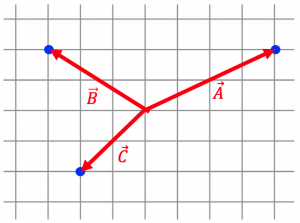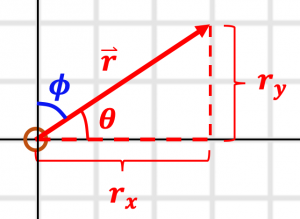3 Vectors
Last section we learned to use a coordinate system to describe an object’s position. As it turns out, dipslacement vectors provide an even better way of doing this. Let’s start with a definition:
A displacement vector is a set of instructions of how to move.
For example, the vector ![]() could be “move
could be “move ![]() m to the right, and
m to the right, and ![]() m upwards,” which we can write as
m upwards,” which we can write as ![]() . If
. If ![]() is negative, then we move left instead of right. If
is negative, then we move left instead of right. If ![]() is negative, we move down instead of up. The quantities
is negative, we move down instead of up. The quantities ![]() and
and ![]() are called the components of the vector
are called the components of the vector ![]() . I know this sounds like this is no different from what we did before, but in the next chapter will discover why thinking about displacement vetors is so useful. For now, let’s consider some properties of vectors.
. I know this sounds like this is no different from what we did before, but in the next chapter will discover why thinking about displacement vetors is so useful. For now, let’s consider some properties of vectors.
Exercise 3.1: Vector Representations
We can represent a displacement vector as an arrow that tells us how to move. E.g. the plot below shows three displacement vectors:
 = “move 3 to the right and 1 down.”
= “move 3 to the right and 1 down.” = “move 1 to the left and 2 down.”
= “move 1 to the left and 2 down.” = “move 3 to the right and 2 up.”
= “move 3 to the right and 2 up.”
Drag each of the labels for vectors ![]() ,
, ![]() , and
, and ![]() to the correct arrow.
to the correct arrow.
The fact that we can represent vectors with arrows makes it obvious that the way in which a vector can give instructions is not unique! E.g. rather than specifying how far we move along the ![]() and
and ![]() axis, we can specify the direction and total distance travelled (e.g. travel 5 mi North-East). In math, the length of a vector (how far we need to go) is called the magnitude.
axis, we can specify the direction and total distance travelled (e.g. travel 5 mi North-East). In math, the length of a vector (how far we need to go) is called the magnitude.
All vectors have both a magnitude and a direction.
The magnitude of a vector ![]() is denoted as
is denoted as ![]() , though the shorthand
, though the shorthand ![]() is also fairly common, and is what I will use in this book.
is also fairly common, and is what I will use in this book.
Exercise 3.2: Calculating Vector Magnitudes
The plot below show the displacement vectors that would take you to see each of your three friends, Aisha (![]() ), Beth (
), Beth (![]() ), and Charlie (
), and Charlie (![]() ). Each grid cell is 1 m across.
). Each grid cell is 1 m across.
Use the diagram below to calculate the magnitude of the vectors ![]() ,
, ![]() , and
, and ![]() . If you are feeling stuck, look at the hint.
. If you are feeling stuck, look at the hint.

We can use the same “trick” of looking at the right triangle formed by the vector and the ![]() and
and ![]() axis to calculate the components of a vector given its magnitude. Let’s try it!
axis to calculate the components of a vector given its magnitude. Let’s try it!
Exercise 3.3: Calculating Vector Components
Consider the vector ![]() shown in the picture below, and let
shown in the picture below, and let ![]() be the vector’s magnitude.
be the vector’s magnitude.

A) Find the ![]() and
and ![]() components of the vector
components of the vector ![]() in terms of the magnitude
in terms of the magnitude ![]() and the angle
and the angle ![]() .
.
B) Now find ![]() and
and ![]() , but use the angle
, but use the angle ![]() instead of
instead of ![]() . There’s a very good reason I’m asking you to do this, which we’ll get to in a second (see warning below).
. There’s a very good reason I’m asking you to do this, which we’ll get to in a second (see warning below).
If you’re not sure how to do part B, we go through the solution in the video below.
Key Takeaways
